“Odette is a fabled princess… a mistress…a judge…a heroine. Odette is both of antiquity and modernity. You will find her in works of fiction and tales from history. Odette encapsulates our inspiration for this property – femininity, strength and power.”
How’s that for an introduction? In this case we’re introducing a new vinous endeavor from Napa Valley’s famed Stags Leap District. Odette is the sister winery of PlumpJack and CADE, founded in Oakville and Howell Mountain respectively by the dynamic trio of Gavin Newsom, Gordon Getty and John Conover. Like its sisters, the name for the project was inspired by Shakespeare, however, Odette was also the name of a French judge from the 1976 Judgment of Paris, an event which rocked the wine world. This legendary blind tasting pitted French against American wine and was judged by some of the most respected palates on the planet; however, in a stunning defeat for the French, a red wine from California’s Stags Leap District took first place, officially putting California wine on the map (Bottle Shock is a great film about this historic event). Comprised of 45 acres, Odette is a new addition to this historic appellation and is dedicated to producing full-bodied Cabernet Sauvignon which represent the region’s unique terroir.
2012 marks the inaugural vintage of Odette and winemaker Jeff Owens is off to a smashing start with the new label. His 2012 Odette Cabernet Sauvignon Reserve was extremely well received, garnering a perfect score of 100 points from esteemed wine critic Robert Parker, the first winemaker to do so in his inaugural vintage. Owens was originally poised for a career in landscape architecture but became smitten with wine, graduating as a member of Cal Poly’s first class in Wine & Viticulture. After completing an internship at Cakebread, he made the move to the smaller, boutique PlumpJack winery where he began as a cellar worker. Owens rose quickly through the ranks and became assistant winemaker at PlumpJack in 2008, and then made the move to CADE in 2010 where he remained until being tapped for the Head Winemaking position at Odette in 2012.
The land for Odette was purchased from the Steltzner family who established their eponymous winery in the Stags Leap District in 1965. The family sold 49 acres to the PlumpJack group while retaining 30 acres on which they will continue to make their own wine. The Stags Leap American Viticultural Area (AVA) is the first in the United States to be approved based on the uniqueness of its soils, which include both loam and clay sediments from the Napa River, as well as volcanic soils from eruptions which took place millions of years ago. These soils are coarse and retain little water, which produce fruit of great intensity and flavor. The Odette team takes their role as “stewards of the land” very seriously and is currently building a LEED Certified winery on the property while also pursuing a rigorous, organic certification for its estate vineyards.
I recently had the pleasure of meeting the affable (and young!) Owens and tasting through the Odette wines at Ft. Lauderdale’s Capital Grille. We began with Odette’s second tier of wines, Adaptation, which consists of a Chardonnay, Petite Sirah and Cabernet Sauvignon made from fruit sourced from the Napa Valley:
The 2013 Adaptation Chardonnay ($32) was pleasantly crisp and refreshing, the result of being fermented and aged primarily in stainless steel – no oak monster here! This wine had delightful notes of white flowers, green apple, and pear complemented by a food friendly acidity and dry finish making it an excellent pairing for the Crab & Lobster Burger.
The 2012 Adaptation Petite Sirah ($36) exhibited this grape’s hallmark, inky purple hue which had my wine glass looking like a stained glass window. Heady aromas of black fruit and spice followed through on the palate with mouth-filling flavors of juicy blackberry, ripe plum, and baking spices. Appreciable tannins and a lengthy finish made this wine a perfect match for the Grille’s juicy Signature Cheeseburger.
The 2012 Adaptation Cabernet Sauvignon ($46) is a “celebration” of classic Napa Cabernet which was aged in 50% new French oak and 50% used for 20 months. The result is a full-bodied red with aromas of bright red fruit, vanilla and spice while on the palate, red currant, cranberry, mocha and smoky oak predominate. Chewy tannins and a lively acidity make this wine an excellent partner for grilled meats such as the Filet Mignon with Cipollini Onions and Wild Mushrooms.
Our final wine of the flight was the 2012 Odette Estate Cabernet Sauvignon ($98), a blend of 75% Cabernet Sauvignon, 14% Merlot and 11% Cabernet Franc from one of Napa’s most acclaimed vintages. This wine had an opaque, purple hue and fragrant aromas of black fruit, cassis and spice. On the palate, this full-bodied beauty revealed layers of black cherry, raspberry, violet, and licorice while tannin and acid struck an elegant balance which persisted through the lengthy finish.
The Adaptation and Odette wines provide wonderful representations of their respective grape varieties as seen through the unique prism of California terroir. I hope you enjoy experiencing them and next time you’re in wine country, be sure to stop in for a visit!
Odette
5998 Silverado Trail, Napa
Telephone: (707) 224-7533
Website: www.odetteestate.com
Cheers,
Mother's Day is fast approaching and I'm sure you'll be treating Mom to a feast fit for a Queen! If you're looking for the perfect wine pairing for your festivities here's 5 Fabulous Wine Recommendations from some of our favorite "Women of the Vine": GIFFT Pinot Noir Rosé, Monterey, California, 2014 ($16): This wine is the newest addition to Kathie Lee Gifford's GIFFT line of wines created in partnership with Scheid Vineyards (for more information, please click here). This delightful dry rosé is crafted from 100% estate grown Pinot Noir from the Scheid family's Mesa del Rio vineyard in Monterey, California, a region known for producing beautiful Chardonnay and Pinot Noir. The grapes were fermented entirely in stainless steel to preserve the fresh, fruity flavors of watermelon, strawberry, and raspberry. A crisp, food-friendly acidity and lengthy finish will keep you coming back for more.
GIFFT Pinot Noir Rosé, Monterey, California, 2014 ($16): This wine is the newest addition to Kathie Lee Gifford's GIFFT line of wines created in partnership with Scheid Vineyards (for more information, please click here). This delightful dry rosé is crafted from 100% estate grown Pinot Noir from the Scheid family's Mesa del Rio vineyard in Monterey, California, a region known for producing beautiful Chardonnay and Pinot Noir. The grapes were fermented entirely in stainless steel to preserve the fresh, fruity flavors of watermelon, strawberry, and raspberry. A crisp, food-friendly acidity and lengthy finish will keep you coming back for more. Elena Walch Pinot Grigio Castel Ringberg, Alto Adige, Italy, 2013 ($22): Elena Walch is a leading wine producer in the Alto Adige region of northeastern Italy. She runs her eponymous winery with the help of her two daughters, Julia and Karoline, and together they produce an array of acclaimed wines. This wine is 100% Pinot Grigio from the Castel Ringberg vineyard. 85% is fermented in stainless steel while the remainder is fermented in used French oak barriques. The result is a lovely incarnation of this grape with ripe aromas of pear, sage and spice with a creamy mouthfeel, zippy acidity and lengthy, clean finish.
Elena Walch Pinot Grigio Castel Ringberg, Alto Adige, Italy, 2013 ($22): Elena Walch is a leading wine producer in the Alto Adige region of northeastern Italy. She runs her eponymous winery with the help of her two daughters, Julia and Karoline, and together they produce an array of acclaimed wines. This wine is 100% Pinot Grigio from the Castel Ringberg vineyard. 85% is fermented in stainless steel while the remainder is fermented in used French oak barriques. The result is a lovely incarnation of this grape with ripe aromas of pear, sage and spice with a creamy mouthfeel, zippy acidity and lengthy, clean finish. Domaine Drouhin Pinot Noir, Dundee Hills Valley, Oregon, 2012 ($44): Maison Joseph Drouhin was established in Burgundy, France in 1880 and the family expanded to Oregon in the late 1980's upon realizing the potential of the Willamette Valley to produce world class Chardonnay and Pinot Noir. Véronique Boss-Drouhin is the family's fourth generation winemaker and is responsible for crafting the family's wines from both Burgundy and Oregon terroirs. This Pinot Noir is a lovely example of her expertise with enticing notes of violet, earth, pomegranate and cherry pie with supple tannins and a deliciously lengthy finish.
Domaine Drouhin Pinot Noir, Dundee Hills Valley, Oregon, 2012 ($44): Maison Joseph Drouhin was established in Burgundy, France in 1880 and the family expanded to Oregon in the late 1980's upon realizing the potential of the Willamette Valley to produce world class Chardonnay and Pinot Noir. Véronique Boss-Drouhin is the family's fourth generation winemaker and is responsible for crafting the family's wines from both Burgundy and Oregon terroirs. This Pinot Noir is a lovely example of her expertise with enticing notes of violet, earth, pomegranate and cherry pie with supple tannins and a deliciously lengthy finish. Hall Cabernet Sauvignon, Napa Valley, California, 2011 ($48): Kathryn Hall is the proprietress of Hall Winery and has been involved in the California wine industry since her family first purchased a vineyard there over thirty years ago. Known for her eponymous Cabernets, this wine is a blend of 97% Cabernet Sauvignon, 2% Petit Verdot and 1% Cabernet Franc which spent 20 months in 55% new French oak. The resulting wine has delicious notes of red currant, plum, tobacco, mocha and spice and is the perfect choice for Moms who crave big, bold reds with oodles of tannin.
Hall Cabernet Sauvignon, Napa Valley, California, 2011 ($48): Kathryn Hall is the proprietress of Hall Winery and has been involved in the California wine industry since her family first purchased a vineyard there over thirty years ago. Known for her eponymous Cabernets, this wine is a blend of 97% Cabernet Sauvignon, 2% Petit Verdot and 1% Cabernet Franc which spent 20 months in 55% new French oak. The resulting wine has delicious notes of red currant, plum, tobacco, mocha and spice and is the perfect choice for Moms who crave big, bold reds with oodles of tannin. Veuve Clicquot Demi-Sec Champagne, France, NV ($70): Barbe Nicole Clicquot Ponsardin (aka Veuve Clicquot or Widow Clicquot) assumed the reigns of her husband's Champagne House in 1805 at the age of 27. Her contributions to Champagne were many including this delicious Demi-Sec, which is slightly sweeter than your standard Brut Champagne, but balanced by an elegant acidity. This blend of all three Champagne grape varieties (Chardonnay, Pinot Noir and Pinot Meunier) exhibits notes of peach, honey and toasted brioche which will make the perfect accompaniment to a lighter, fruit-based dessert.Please join us this Thursday, May 7th for our Mother's Day Wine Tasting featuring Kathie Lee Gifford's GIFFT Wines at Linen Closet in downtown Delray Beach. Come sip, sample and shop with us and for more information, please click here. I'd also like to wish all you fabulous Moms out there a very Happy Mother's Day!Cheers,
Veuve Clicquot Demi-Sec Champagne, France, NV ($70): Barbe Nicole Clicquot Ponsardin (aka Veuve Clicquot or Widow Clicquot) assumed the reigns of her husband's Champagne House in 1805 at the age of 27. Her contributions to Champagne were many including this delicious Demi-Sec, which is slightly sweeter than your standard Brut Champagne, but balanced by an elegant acidity. This blend of all three Champagne grape varieties (Chardonnay, Pinot Noir and Pinot Meunier) exhibits notes of peach, honey and toasted brioche which will make the perfect accompaniment to a lighter, fruit-based dessert.Please join us this Thursday, May 7th for our Mother's Day Wine Tasting featuring Kathie Lee Gifford's GIFFT Wines at Linen Closet in downtown Delray Beach. Come sip, sample and shop with us and for more information, please click here. I'd also like to wish all you fabulous Moms out there a very Happy Mother's Day!Cheers,
Mother’s Day is fast approaching and I’m sure you’ll be treating Mom to a feast fit for a Queen! If you’re looking for the perfect wine pairing for your festivities here’s 5 Fabulous Wine Recommendations from some of our favorite “Women of the Vine”: GIFFT Pinot Noir Rosé, Monterey, California, 2014 ($16): This wine is the newest addition to Kathie... Read More
The post 5 Fabulous Mother’s Day Wine Recommendations! appeared first on The Glamorous Gourmet.
Mother’s Day is fast approaching and I’m sure you’ll be treating Mom to a feast fit for a Queen! If you’re looking for the perfect wine pairing for your festivities here’s 5 Fabulous Wine Recommendations from some of our favorite “Women of the Vine”:
 GIFFT Pinot Noir Rosé, Monterey, California, 2014 ($16): This wine is the newest addition to Kathie Lee Gifford’s GIFFT line of wines created in partnership with Scheid Vineyards (for more information, please click here). This delightful dry rosé is crafted from 100% estate grown Pinot Noir from the Scheid family’s Mesa del Rio vineyard in Monterey, California, a region known for producing beautiful Chardonnay and Pinot Noir. The grapes were fermented entirely in stainless steel to preserve the fresh, fruity flavors of watermelon, strawberry, and raspberry. A crisp, food-friendly acidity and lengthy finish will keep you coming back for more.
GIFFT Pinot Noir Rosé, Monterey, California, 2014 ($16): This wine is the newest addition to Kathie Lee Gifford’s GIFFT line of wines created in partnership with Scheid Vineyards (for more information, please click here). This delightful dry rosé is crafted from 100% estate grown Pinot Noir from the Scheid family’s Mesa del Rio vineyard in Monterey, California, a region known for producing beautiful Chardonnay and Pinot Noir. The grapes were fermented entirely in stainless steel to preserve the fresh, fruity flavors of watermelon, strawberry, and raspberry. A crisp, food-friendly acidity and lengthy finish will keep you coming back for more.
 Elena Walch Pinot Grigio Castel Ringberg, Alto Adige, Italy, 2013 ($22): Elena Walch is a leading wine producer in the Alto Adige region of northeastern Italy. She runs her eponymous winery with the help of her two daughters, Julia and Karoline, and together they produce an array of acclaimed wines. This wine is 100% Pinot Grigio from the Castel Ringberg vineyard. 85% is fermented in stainless steel while the remainder is fermented in used French oak barriques. The result is a lovely incarnation of this grape with ripe aromas of pear, sage and spice with a creamy mouthfeel, zippy acidity and lengthy, clean finish.
Elena Walch Pinot Grigio Castel Ringberg, Alto Adige, Italy, 2013 ($22): Elena Walch is a leading wine producer in the Alto Adige region of northeastern Italy. She runs her eponymous winery with the help of her two daughters, Julia and Karoline, and together they produce an array of acclaimed wines. This wine is 100% Pinot Grigio from the Castel Ringberg vineyard. 85% is fermented in stainless steel while the remainder is fermented in used French oak barriques. The result is a lovely incarnation of this grape with ripe aromas of pear, sage and spice with a creamy mouthfeel, zippy acidity and lengthy, clean finish.
 Domaine Drouhin Pinot Noir, Dundee Hills Valley, Oregon, 2012 ($44): Maison Joseph Drouhin was established in Burgundy, France in 1880 and the family expanded to Oregon in the late 1980’s upon realizing the potential of the Willamette Valley to produce world class Chardonnay and Pinot Noir. Véronique Boss-Drouhin is the family’s fourth generation winemaker and is responsible for crafting the family’s wines from both Burgundy and Oregon terroirs. This Pinot Noir is a lovely example of her expertise with enticing notes of violet, earth, pomegranate and cherry pie with supple tannins and a deliciously lengthy finish.
Domaine Drouhin Pinot Noir, Dundee Hills Valley, Oregon, 2012 ($44): Maison Joseph Drouhin was established in Burgundy, France in 1880 and the family expanded to Oregon in the late 1980’s upon realizing the potential of the Willamette Valley to produce world class Chardonnay and Pinot Noir. Véronique Boss-Drouhin is the family’s fourth generation winemaker and is responsible for crafting the family’s wines from both Burgundy and Oregon terroirs. This Pinot Noir is a lovely example of her expertise with enticing notes of violet, earth, pomegranate and cherry pie with supple tannins and a deliciously lengthy finish.
 Hall Cabernet Sauvignon, Napa Valley, California, 2011 ($48): Kathryn Hall is the proprietress of Hall Winery and has been involved in the California wine industry since her family first purchased a vineyard there over thirty years ago. Known for her eponymous Cabernets, this wine is a blend of 97% Cabernet Sauvignon, 2% Petit Verdot and 1% Cabernet Franc which spent 20 months in 55% new French oak. The resulting wine has delicious notes of red currant, plum, tobacco, mocha and spice and is the perfect choice for Moms who crave big, bold reds with oodles of tannin.
Hall Cabernet Sauvignon, Napa Valley, California, 2011 ($48): Kathryn Hall is the proprietress of Hall Winery and has been involved in the California wine industry since her family first purchased a vineyard there over thirty years ago. Known for her eponymous Cabernets, this wine is a blend of 97% Cabernet Sauvignon, 2% Petit Verdot and 1% Cabernet Franc which spent 20 months in 55% new French oak. The resulting wine has delicious notes of red currant, plum, tobacco, mocha and spice and is the perfect choice for Moms who crave big, bold reds with oodles of tannin.
 Veuve Clicquot Demi-Sec Champagne, France, NV ($70): Barbe Nicole Clicquot Ponsardin (aka Veuve Clicquot or Widow Clicquot) assumed the reigns of her husband’s Champagne House in 1805 at the age of 27. Her contributions to Champagne were many including this delicious Demi-Sec, which is slightly sweeter than your standard Brut Champagne, but balanced by an elegant acidity. This blend of all three Champagne grape varieties (Chardonnay, Pinot Noir and Pinot Meunier) exhibits notes of peach, honey and toasted brioche which will make the perfect accompaniment to a lighter, fruit-based dessert.
Veuve Clicquot Demi-Sec Champagne, France, NV ($70): Barbe Nicole Clicquot Ponsardin (aka Veuve Clicquot or Widow Clicquot) assumed the reigns of her husband’s Champagne House in 1805 at the age of 27. Her contributions to Champagne were many including this delicious Demi-Sec, which is slightly sweeter than your standard Brut Champagne, but balanced by an elegant acidity. This blend of all three Champagne grape varieties (Chardonnay, Pinot Noir and Pinot Meunier) exhibits notes of peach, honey and toasted brioche which will make the perfect accompaniment to a lighter, fruit-based dessert.
Please join us this Thursday, May 7th for our Mother’s Day Wine Tasting featuring Kathie Lee Gifford’s GIFFT Wines at Linen Closet in downtown Delray Beach. Come sip, sample and shop with us and for more information, please click here. I’d also like to wish all you fabulous Moms out there a very Happy Mother’s Day!
Cheers,
Don your beret and grab a glass of Chablis, my fellow wine lovers – it’s time for a little French lesson for our latest Wine Word of the Week! Bâtonnage (bat-un-AJH) is a French term which refers to the stirring of a wine which is being fermented sur lie, or “on the lees.” Lees refers to the dead yeast cells... Read More
The post Wine Word of the Week: Bâtonnage! appeared first on The Glamorous Gourmet.
Don your beret and grab a glass of Chablis, my fellow wine lovers – it’s time for a little French lesson for our latest Wine Word of the Week!
Bâtonnage (bat-un-AJH) is a French term which refers to the stirring of a wine which is being fermented sur lie, or “on the lees.” Lees refers to the dead yeast cells and other matter which collects at the bottom of the barrel as a normal byproduct of fermentation. Allowing the wine to remain in contact with these cells imparts a fuller, richer body and more complexity to the wine. Stirring or bâtonnage facilitates this process by maximizing the wine’s exposure to the lees. The extent to which this technique is employed is determined by the winemaker and the style of wine he or she is trying to produce. The more contact the wine has with the dead yeast cells, the more effect it will have on the wine.
Because they are intrinsically linked, you will usually see the terms “sur lie” and “bâtonnage” used together. These techniques are best known for their role in producing white wines such as White Burgundy as well as New World incarnations of the Chardonnay grape.
I hope you enjoyed our latest Wine Word of the Week, to view previous installments of this segment please click here. If you have a wine word you’d like to learn more about, please tell us in the comment section below – thanks for stopping by!
Cheers,
The flowers are blooming, the birds are chirping and sunny days are steadily replacing the gloom of winter. Spring is upon us and one of my favorite wines to enjoy this time of year is Chablis. These wines should not be confused with the low quality, jug wine made infamous in the 1970's. In fact, quite the contrary, authentic Chablis is all about freshness, elegance and purity.Chablis is the northernmost wine district of Burgundy, one of France's most acclaimed wine regions. This is undeniably white wine country and Chablis' signature grape is Chardonnay. Unlike Chardonnay produced in warmer climates such as California, Burgundy's cool climate produces wines which are light and lemony, and known more for their lively acidity and minerality than opulent fruit and spice. These wines are perfect for sipping on a bright, sunny Spring day or paired with a wide variety of cuisines.I recently had the pleasure of attending a Chablis tasting in Miami at La Mar by Gastón Acurio located in the tony Mandarin Oriental Hotel. This chic Peruvian eatery strategically overlooks both the beautiful Biscayne Bay and dramatic Miami skyline. Since it was a beautiful sunny South Florida day, we enjoyed our tasting al fresco, guided by our charming host, Jean François Bordet, President of the Chablis Wine Board and proprietor of Domaine Séguinot-Bordet, his family's winery founded in 1590.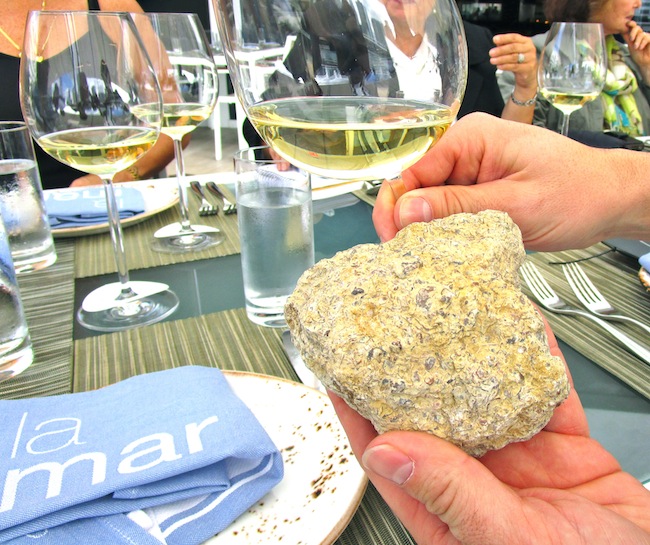 Our tasting involved a selection of wines from three of Chablis' four appellations which are: Petit Chablis, Chablis, Chablis Premier Cru and Chablis Grand Cru. When sampling Burgundian wine, the concept of terroir is always at the forefront (for more information on "terroir" please click here).Terroir essentially refers to the intersection of soil, grape variety, climate and winemaker influence and how these factors come together to create a wine that is unique to a specific place which cannot be produced anywhere else in the world. Key to this theory are Climats, or designated plots of land with specific geological and climatic conditions, which impart their own unique impression on wine.
Our tasting involved a selection of wines from three of Chablis' four appellations which are: Petit Chablis, Chablis, Chablis Premier Cru and Chablis Grand Cru. When sampling Burgundian wine, the concept of terroir is always at the forefront (for more information on "terroir" please click here).Terroir essentially refers to the intersection of soil, grape variety, climate and winemaker influence and how these factors come together to create a wine that is unique to a specific place which cannot be produced anywhere else in the world. Key to this theory are Climats, or designated plots of land with specific geological and climatic conditions, which impart their own unique impression on wine.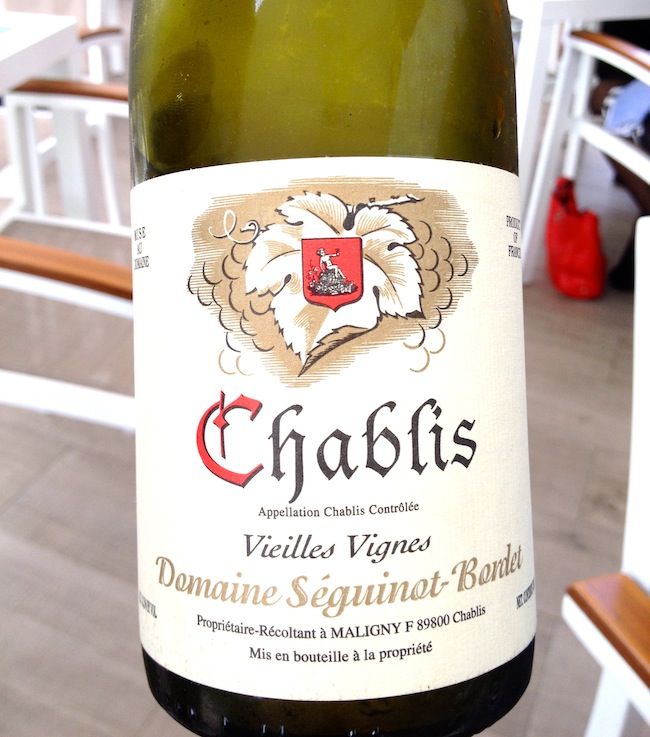 The soils of Chablis are legendary for their limestone content and were formed long ago in the Kimmeridgian period (Upper Jurassic era). This unique soil contains millions of fossils of oysters and other marine creatures and is primarily found in the Chablis and Premier Cru appellations.Petit Chablis, on the other hand, is situated on soils formed more recently, which contain limestone from the Portlandian period. The Chablis Grand Cru vines grow on steep slopes rife with Kimmeridgian limestone as well as an extremely rich subsoil.
The soils of Chablis are legendary for their limestone content and were formed long ago in the Kimmeridgian period (Upper Jurassic era). This unique soil contains millions of fossils of oysters and other marine creatures and is primarily found in the Chablis and Premier Cru appellations.Petit Chablis, on the other hand, is situated on soils formed more recently, which contain limestone from the Portlandian period. The Chablis Grand Cru vines grow on steep slopes rife with Kimmeridgian limestone as well as an extremely rich subsoil.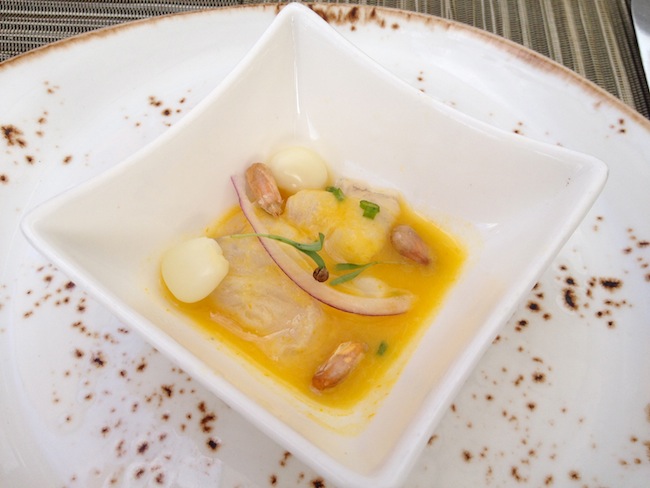 Our tasting featured a selection of wines which beautifully represented their respective appellations. Chef Acurio prepared an assortment of delicious dishes to pair with each group of wines which were served in three consecutive flights.Our first flight featured one wine, the 2013 Domaine Séguinot-Bordet Chablis Vieilles Vignes. Vieilles Vignes means "old vines" which, in this case, are 78 years old and located on the family's 40 acre estate in Maligny. The wine was fermented in oak barrels (15% new) and stainless steel (85%) resulting in a fresh, lively wine that was a classic example of the region!The wine paired beautifully with Chef's dishes which included Cebiche Nikei with tuna, red onion, nori, avocado, daikon cucumber, and tamarind leche de tigre; Causa Congrejo featuring beet causa, crab, avocado, huancaina sauce, fried kale, cherry tomatoes and quail egg; and a perennial favorite, Empanadas with pork adobo and pepian de choclo, chalaca, and huacatay sauce. Chef Acurio's dishes were as much a feast for the eyes as the palate and the wine definitely held it's own amidst the onslaught of deliciousness. It's hallmark acidity tempered the richness and variety of textures while also allowing the flavors of the food to shine through.
Our tasting featured a selection of wines which beautifully represented their respective appellations. Chef Acurio prepared an assortment of delicious dishes to pair with each group of wines which were served in three consecutive flights.Our first flight featured one wine, the 2013 Domaine Séguinot-Bordet Chablis Vieilles Vignes. Vieilles Vignes means "old vines" which, in this case, are 78 years old and located on the family's 40 acre estate in Maligny. The wine was fermented in oak barrels (15% new) and stainless steel (85%) resulting in a fresh, lively wine that was a classic example of the region!The wine paired beautifully with Chef's dishes which included Cebiche Nikei with tuna, red onion, nori, avocado, daikon cucumber, and tamarind leche de tigre; Causa Congrejo featuring beet causa, crab, avocado, huancaina sauce, fried kale, cherry tomatoes and quail egg; and a perennial favorite, Empanadas with pork adobo and pepian de choclo, chalaca, and huacatay sauce. Chef Acurio's dishes were as much a feast for the eyes as the palate and the wine definitely held it's own amidst the onslaught of deliciousness. It's hallmark acidity tempered the richness and variety of textures while also allowing the flavors of the food to shine through.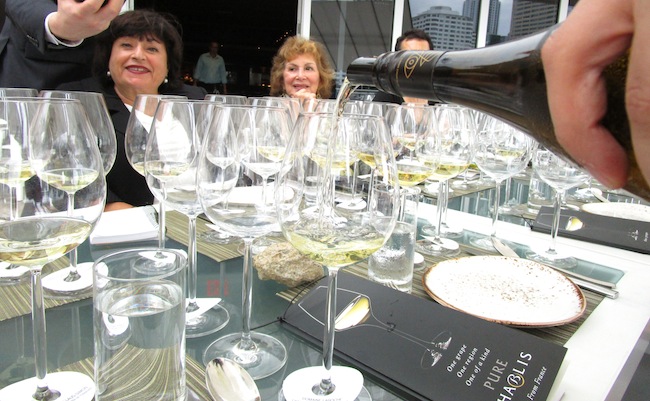 The second course featured three Chablis offerings from the Premier Cru appellation which is comprised of 40 individual Climats, 17 of which are most prominent.These wines generally exhibit more complexity and structure than basic Chablis and have good aging potential as well, approximately 5 to 10 years. The words "Premier Cru" and the name of the Climat of origin may be added to the name Chablis on the wine's label.
The second course featured three Chablis offerings from the Premier Cru appellation which is comprised of 40 individual Climats, 17 of which are most prominent.These wines generally exhibit more complexity and structure than basic Chablis and have good aging potential as well, approximately 5 to 10 years. The words "Premier Cru" and the name of the Climat of origin may be added to the name Chablis on the wine's label.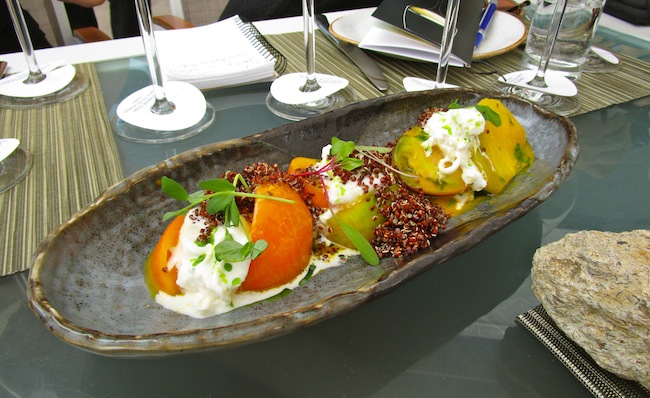 The three wines in our second flight included the 2011 Maison Simonnet Febvre Chablis 1er Cru Vaillons; 2011 Domaine Billaud-Simon Chablis 1er Cru Montée de Tonnerre; and the 2009 Domaine Oudin Chablis 1er Cru Vaugiraut. This collection of wines provided an insightful snapshot of the Premier Cru appellation.The Simmonet Febvre Vaillons had notes of white peach and citrus with a clean, racy acidity and lengthy finish; the Billaud-Simon Montée de Tonnerre was a study in elegance with floral and mineral aromas accompanied by vibrant citrus, limestone and gunflint; the Domaine Oudin Vaugiraut was slightly older than the two other wines and had a slight oxidative quality in addition to notes of gunflint, minerality and citrus.Chef Acurio's Quinoa Caprese was beautifully colorful with heirloom tomatoes, basil, red quinoa, burrata cheese with an aji amarillo vinaigrette which paired best with the Domain Oudin Vaugiraut. The Seared Scallop Conchitas with lomo saltado sauce, garlic chips and crispy sweet potato strings paired brilliantly with the other two wines.
The three wines in our second flight included the 2011 Maison Simonnet Febvre Chablis 1er Cru Vaillons; 2011 Domaine Billaud-Simon Chablis 1er Cru Montée de Tonnerre; and the 2009 Domaine Oudin Chablis 1er Cru Vaugiraut. This collection of wines provided an insightful snapshot of the Premier Cru appellation.The Simmonet Febvre Vaillons had notes of white peach and citrus with a clean, racy acidity and lengthy finish; the Billaud-Simon Montée de Tonnerre was a study in elegance with floral and mineral aromas accompanied by vibrant citrus, limestone and gunflint; the Domaine Oudin Vaugiraut was slightly older than the two other wines and had a slight oxidative quality in addition to notes of gunflint, minerality and citrus.Chef Acurio's Quinoa Caprese was beautifully colorful with heirloom tomatoes, basil, red quinoa, burrata cheese with an aji amarillo vinaigrette which paired best with the Domain Oudin Vaugiraut. The Seared Scallop Conchitas with lomo saltado sauce, garlic chips and crispy sweet potato strings paired brilliantly with the other two wines.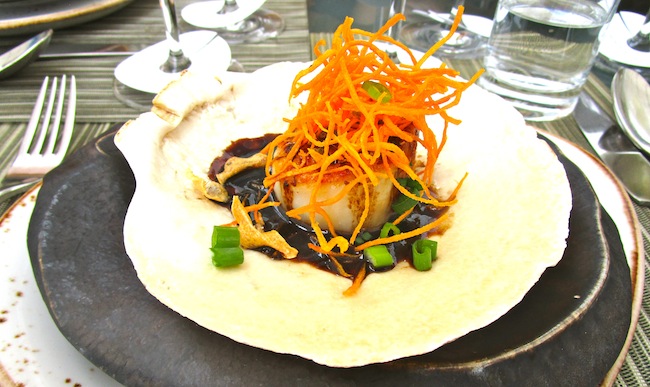 The third course featured two wines from Chablis' Grand Cru appellation which consists of seven Climats: Blanchot, Bougros, Les Clos, Grenouilles, Preuses, Valmur and Vaudésir.These wines represent the jewel in the crown of the Chablis region. They also have the most aging potential (usually around 7-10 years), a more generous mouthfeel, lengthier finish and more complexity which is usually manifested in notes of spice, honey, almond and dried fruit.
The third course featured two wines from Chablis' Grand Cru appellation which consists of seven Climats: Blanchot, Bougros, Les Clos, Grenouilles, Preuses, Valmur and Vaudésir.These wines represent the jewel in the crown of the Chablis region. They also have the most aging potential (usually around 7-10 years), a more generous mouthfeel, lengthier finish and more complexity which is usually manifested in notes of spice, honey, almond and dried fruit.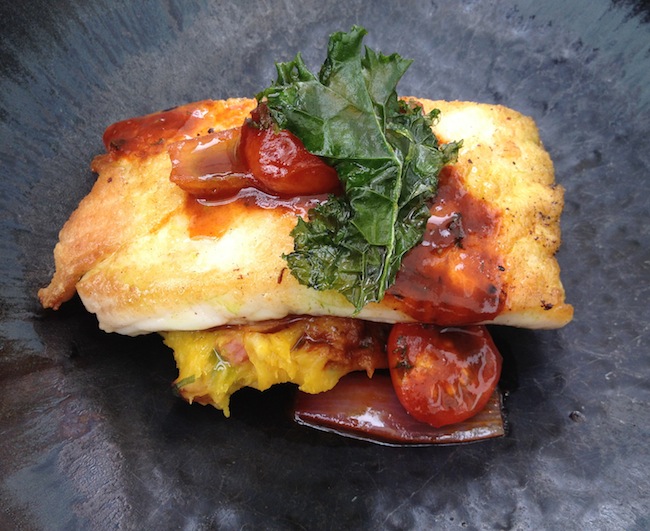
 The two Grand Cru wines featured in our third course were the 2010 Maison Drouhin Vaudon Chablis Grand Cru Vaudésir and the 2009 Domaine Laroche Chablis Grand Cru Blanchot.The Drouhin Vaudon Vaudésir, served en magnum, is a product of thirty year old vines whose grapes were manually harvested and gently pressed to preserve the quality of the fruit. The wine was then fermented entirely in French oak (0% new) for 12 months and the resulting wine offered a complex array peach, honey, spice and almond with a lengthy, mineral-tinged finish. This nuanced wine had a rich texture yet was also was bright and lively with plenty of finesse - a beautiful effort!The Domaine Laroche Blanchot, a product of 45 year old vines, was also manually harvested and fermented partially in stainless steel (60%) while the remainder went into French oak barrels (15% new) for 14 months. The resulting wine was also lovely and layered with notes of peach, apple, limestone and honey which continued to evolve in the glass over our third course. To enjoy with our Grand Cru Chablis, Chef Acurio prepared a mouth watering Amazon fish with tamarind chorillana sauce, yucca and smoked bacon - a truly divine pairing!
The two Grand Cru wines featured in our third course were the 2010 Maison Drouhin Vaudon Chablis Grand Cru Vaudésir and the 2009 Domaine Laroche Chablis Grand Cru Blanchot.The Drouhin Vaudon Vaudésir, served en magnum, is a product of thirty year old vines whose grapes were manually harvested and gently pressed to preserve the quality of the fruit. The wine was then fermented entirely in French oak (0% new) for 12 months and the resulting wine offered a complex array peach, honey, spice and almond with a lengthy, mineral-tinged finish. This nuanced wine had a rich texture yet was also was bright and lively with plenty of finesse - a beautiful effort!The Domaine Laroche Blanchot, a product of 45 year old vines, was also manually harvested and fermented partially in stainless steel (60%) while the remainder went into French oak barrels (15% new) for 14 months. The resulting wine was also lovely and layered with notes of peach, apple, limestone and honey which continued to evolve in the glass over our third course. To enjoy with our Grand Cru Chablis, Chef Acurio prepared a mouth watering Amazon fish with tamarind chorillana sauce, yucca and smoked bacon - a truly divine pairing!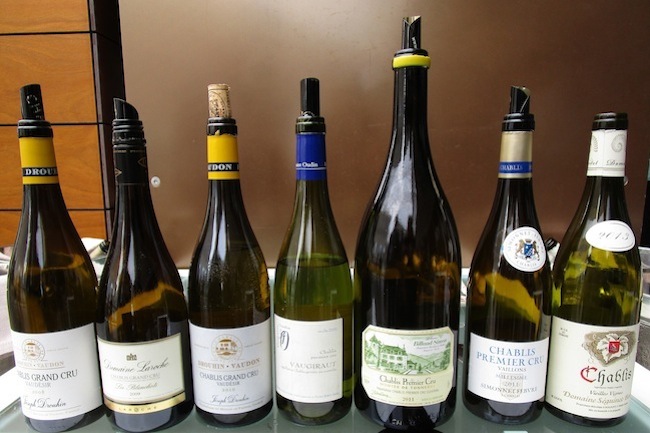 I hope after reading this post you also feel inspired to explore the delightful wines of Chablis this Spring! And for more information on the Chablis region, please go ahead and click here.Cheers,
I hope after reading this post you also feel inspired to explore the delightful wines of Chablis this Spring! And for more information on the Chablis region, please go ahead and click here.Cheers,